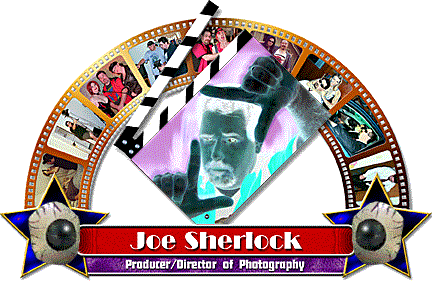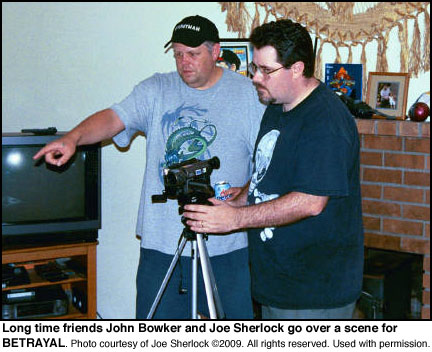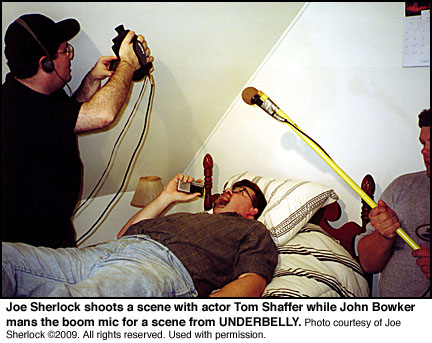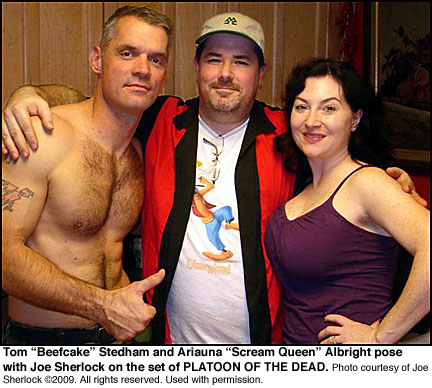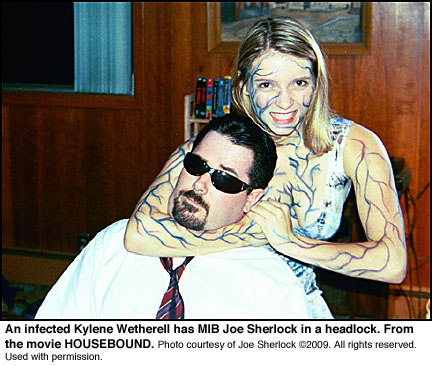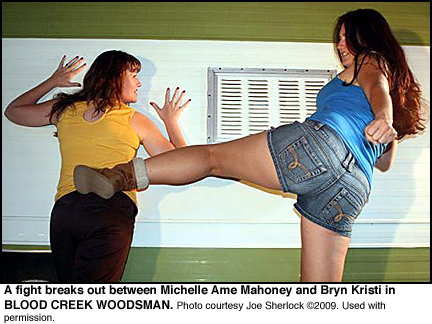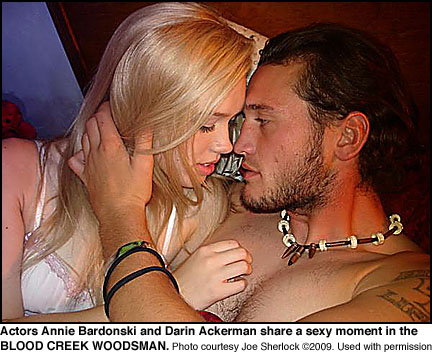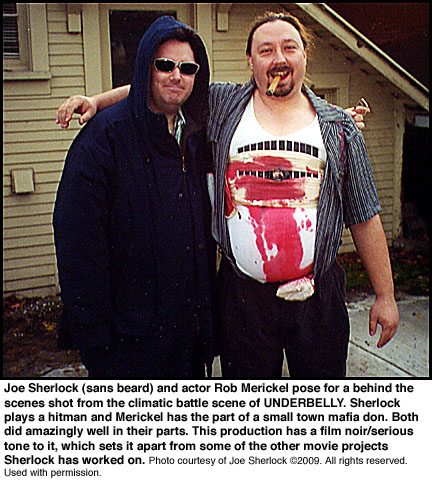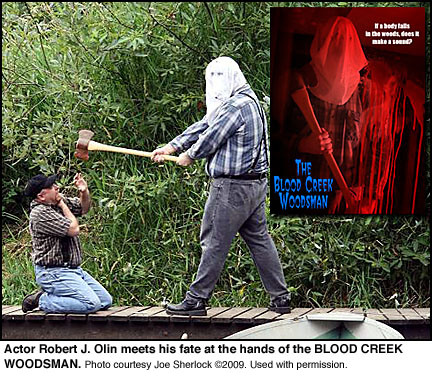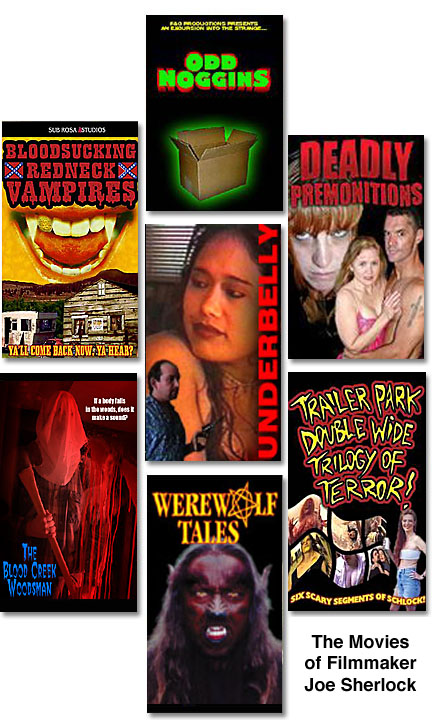Search
An Interview with Independent Filmmaker Joe Sherlock
by Robert Long II ©2009
Robert: Joe, you have worked mainly in video: What are the pros and cons of video versus film?
Joe: The big pro is that videotape is cheaper as there are no film processing costs. You can immediately look at a take on video while you have to wait days, and sometimes weeks on indie productions, to see if something looked good on film. I think it’s important to note that while many producers, big and small, have turned to digital video, the real reason is that it can look so much like film these days. The general public still wants the LOOK of film – they don’t care if it was really shot on film or if it was shot on digital video and processed in-camera or in a computer.
The only real problem I’ve run into because I shoot on tape is trying to show a movie locally – not many small towns will have theaters set-up for video projection, but more and more have it everyday. I have had movies shown digitally in a couple of theaters and hope to do it more.
Robert: What kind of affordable film or video camera would you recommend to those in the independent film business? What are the pluses and features on these cameras?
Joe: When this interview was originally done in 2004, the primo camera for the indie moviemaker was the Panasonic DVX100. I shot “Bloodsucking Redneck Vampires” with one and I was amazed at how good things looked right in camera using the “cinelook” effect. A bit of tweaking in editing and it looked like many a shot-on-film broadcast TV movie to me. Still, you were looking at spending $3000 or so. Most recently one of my filmmaking partners picked up the Canon HV40 for under $1000 (with some nice attachments and such). It’s HD, which many distributors are wanting these days, although you can still find ones that will take whatever you’ve got, HD or not. For many moviemakers, these expenses are a major minus. As with everything else in micro-budget moviemaking, do the best you can with what you’ve got. I shot multiple features and shorts with a Sony Hi8 camera and had a number of people think that it was shot digitally. If all you have is VHS, shoot something on VHS. If you wait and wait for the “perfect” set of equipment, you will never make your movie.
Robert: What kind of lighting equipment do you use? What do you feel is essential as a basic kit for someone starting out in this business?
Joe: I have a three-light Lowel kit that uses halogen bulbs. I’ve accented that with some plain old halogen worklights from Home Depot and a selection of colored gels. I think that’s a good basic set-up from someone just starting out. Light is very important when you are shooting on video. Your worst enemy is low light because you will get a grainy look that cannot be fixed in post. Many years ago my friend Colin O’Neill told me “light it hot, crank it down,” meaning light the scene very well then turn down the exposure setting on the camera until it looks good in the viewfinder or monitor. You still want to be creative with your lighting: have intentionally bright areas, intentionally dim areas, use colors, pay attention to shadows, etc., but just err on the brighter side and adjust things in camera, or in post-production if you need to.
Robert: Joe, your last several movies have been with your friend John Bowker of Pipedream Productions. What are pros and cons to this collaborative effort? What compromises have to be met to have a good creative team up?
Joe: On the positive side, John and I have been friends since high school and we’re into the same types of movies and music. I think that background gives you a good foundation when working together. We can communicate and be honest with each other, having been friends for so long. That also gives us a wealth of experiences to reference and draw upon. There have been situations on set where John can refer to something that happened years ago and I know exactly what he’s talking about, and therefore what he’s meaning in regards to a shot or scene. It’s very easy for us to be on the same wavelength and after working on so many projects together, getting in sych is easier than ever.
In some cases, being friends for so long can be problematic – we certainly can’t b.s. each other to get what we want! Knowing each others’ sore spots, it’s sometimes easy to pick in each other, especially when it’s
Compromise is the name of the game in no-budget video whether you are working as friends or not. You always have to be ready to change plans as people, places and things fall apart around you. John and I perhaps handle that better with us both knowing how these projects go. As far as personal compromises, when I’m working as a DP for one of John’s projects, I have to keep in mind that it is his vision, not mine. I may have other ideas on how a script would work or a scene should be played, and sometimes I’ll voice that opinion, but I always have to defer to John as it’s his show.
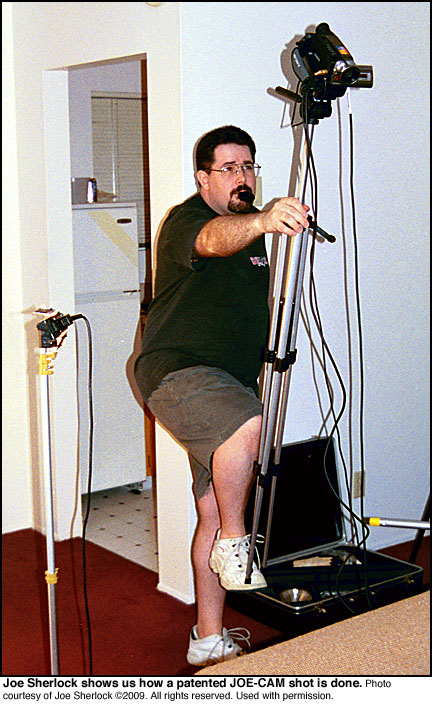
Robert: What kind of preplanning do you do for an upcoming film? Do you storyboard? Do you hold script meetings to get feedback on what will and will not work?
Joe: I try and do as much pre-planning as I can. I create all kinds of shooting schedules, scene breakdowns, lots of storyboards, prop lists, etc. You can never be too prepared. Because I am such a visual person he storyboards are very important to me. Often I will get so caught up in technical or “people” matters on set that I can forget certain cool angles or shots that I’d wanted. The storyboards keep me on track with that. I use to be a small-press comic book artist and those skills have come in handy for storyboards. The other that is nice is that I can just show an actor a storyboard and they know exactly what the shot will be: what’s seen, what is not, how the action has to go within the frame, etc.
I have not held script meetings. I tend to be pretty solitary when writing stuff and when I’m done, I’m pretty much done with it. I certainly listen to comments and suggestions, but more often than not they are changes I decide not to make.
Robert: Are your films self-financed, or do you have investors? If you have investors, what is your advice on how to obtain them?
Joe: All of my projects but one has been self-financed. I’ve worked freelance jobs, sold parts of my comic book collection, sold my videos, magazines, mowed lawns, used birthday money, traded services and all kinds of other things in order to pay for making my movies. Many folks enjoy working on these movies for the fun of it plus food and a free copy of the finished project.
In the one case where I had investors, I actually sold what I called the “Producer’s Package.” Folks would get their name listed in the credits, a special certificate, a finished copy of the movie and periodic updates via newsletter and e-mail of the movie’s production. I spent over 3 years on that movie, selling “packages” along the way. In the end, I only sold five “packages,” but two of the actors kicked in some extra money to be listed as producers. It was a moderate success as far as raising production funds, but a lot of work and I still paid for much of the expenses myself.
If I had any advice on obtaining funding, I’d be taking it myself! There are countless books and websites out there that talk about getting your promo package together, contacting folks like dentists and doctors, etc. I have to admit I’ve never really tried those methods, preferring to be as much of a “one-man-show” as I can.
Robert: What, of all your projects, has had the largest budget? Which has had the smallest budget?
Joe: Well, of the things I’ve worked on with John Bowker so far, “The Evilmaker” had the largest budget, which included flying in actress Stephanie Beaton from
The smallest budget was probably my first movie, “Dimension of Blood.” Everyone was working for fun and food. Props were mostly things I had already or made.
Robert: Can you give me examples of where the money goes on a project? Can you give me cost reasons of why one film is more expensive than the other?
Joe: I’ll compare “Bloodsucking Redneck Vampires” with “Underbelly.” BRV had over 40 speaking parts, plus a lot of extras, so the deferred cast pay was a lot more than for “Underbelly” which had 9 main parts and a few small cameos.
The food on “Underbelly” is a bit hard to track as the shooting was spread out over 12 months, but there was a long weekend where we ate several meals at the restaurant that was one of the locations. Most of the other shoots were a single evening or part of a day where food wasn’t even part of the schedule. BRV was mostly shot on location in a small town in rural
Special effects and make-up are another part of the budget to consider. For “Underbelly” it simply involved a character getting shot in addition to some bruise make-up and glamour make-up for the ladies. For BRV it involved redneck outfits, a number of food props, pale make-up for vampires, several sets of vampire fangs, vampires getting staked effects, a crushed head effect and a good amount of practical and glamour make-up. All of those supplies from corn syrup to overalls add up.
On “Underbelly” there was a tiny bit of travel as well as me having to pay for one actor’s rental car due to scheduling conflicts one weekend. For BRV there were a few folks who requested gas money given how remote the location was. Once actor had to drive seven hours each way for one shoot!
Other things to take into account are equipment costs. You may already have a camera and lights, but you need to buy raw tape stock and may need to get extra batteries, cords, gels, etc.
Robert: Joe, who comes up with the story and the script? Is it a collaborative effort? Do you allow outside contributors to submit a story outline or synopsis?
Joe: “Bloodsucking Redneck Vampires” was the first real collaboration I’ve ever done in regards to scriptwriting. From the get-go Mike Hegg and I wrote it together. I have shot/directed a few anthology segments and parts of movies that other’s wrote. Everything else I’ve done, I’ve written myself. BRV was a very interesting experience as Mike and I have different senses of humor as well as very different styles of writing. Mike sort of gets it all out on paper, then goes back and edits later. I tend to edit more in my head and come out with tighter, leaner text.
Robert: Can you tell me how do you go about holding auditions for a new project? How do you get the word out?
Joe: For the most part I’ve been able to cast from friends and people I’ve worked with in the past who started as friends of friends. For “UNDERBELLY,” I ran a few classified ads in the local college paper. I did have three responses and two girls ended up auditioning as a result. Lately, MySpace and Facebook have been an incredible help in casting – asking folks you know if they are interested or asking folks if they have friends who might be interested.
Robert: Where do you hold the auditions?
Joe: For those two “UNDERBELLY” auditions, I held on in my kitchen and the other one in a public park. Recently for “BLOOD CREEK WOODSMAN,” I drove to an old friend’s place about an hour away to have his girlfriend do some line readings. Often, though, it’s either people I’ve worked with before or friends of friends who only have a few lines, so I don’t bother with auditions.
Robert: Do you have any sort of form for the actors to initially fill out at the audition?
Joe: I usually have actors sign release forms at a read-thru or the shoot. It’s a form I cobbled together from examples I found on the internet.
Robert: Do you video tape the auditions?
Joe: I did try videotaping those auditions for ‘UNDERBELLY,’ but otherwise, no. While it was a bit helpful to go back and watch them, I also really had gut feelings at the time of the auditions which my casting decisions were based on, so I usually don’t bother.
Robert: Do you allow actors to send in video taped auditions with their resumé?
Joe: I haven’t had the opportunity for this yet, but would certainly be open to that.
Robert: Do you feel it is important to get together with the cast and crew before shooting officially commences to go over the film, the plot, the duties of the individuals, and conduct and etiquette on the set?
Joe: In a perfect world I think that is a great idea, but most of the time it’s hard enough to align people’s schedules for a shoot, much less a read-thru. I have done them in small ways, often with a few key actors or crew or sometimes with novice actors. Once I met with an actress and the lead actor at a local pizza parlor and had them run lines about 20 times until the actress really got the right rhythm and delivery I was looking for. However, even after all of that, she still had a lot of trouble with her lines at the shoot! More often than not I just have actors go through their scenes over and over again while I am setting up camera and lights. That way I can adjust their performances right before we shoot.
Robert: Besides the cast, what does your crew usually consist of?
Joe: In most cases I am the director as well as running camera, sound and lights. Sometimes I have had an extra person to run sound. Sometimes I’ve had a person or two just to help move stuff around between shots. In a couple of rare cases, I’ve had a person along as a script supervisor. I’ve done some make-up but have also had an experienced make-up artist on many sets. More often than not, it’s me and one other person trying to do everything.
Robert: Joe, as you probably do not have a grip truck, how is equipment gotten from location to location?
Joe: Any way we can – usually my car…and others’ cars if need be.
Robert: How is costuming handled on a project? Is it “everybody wear what you want to wear” or are the costumes actually cleaned and put back on the rack at the end of the day? Does the cast supply their own costuming, is it supplied to them, or do you have a wardrobe allowance for them?
Joe: In general, people bring their own outfits. I have a small collection of masks, cloaks, hats, etc. that are sometimes used. I’ve purchased a few items for specific shoots: shirts that were going to get squibs blown through them, a pair of overalls for a redneck character, etc. In some cases, I know actors who have certain outfits (sexy leather get-ups, suits, dresses, lingerie, etc.) that I write into a movie. I recently purchased a set of four coveralls that I hope to use as astronaut outfits in a project someday. At $103, it’s probably the biggest wardrobe purchase I’ve ever made!
Robert: You have worked mostly on natural locations. What are the pros and cons of that, rather than working on a set?
Joe: One pro is obviously that in most cases there is very little set-dressing needed – you just go and find the wooded area, home interior, bar or whatever that seems to work “as is.” Also, there’s very little, “break down” time – once you are done, you get your cameras, lights, etc. out of there and aside from perhaps moving a chair back into place you are generally ready to go. Obviously the drawbacks include having to work within often small spaces, working around property-owners’ schedules, sometimes having to travel quite far to get to that “perfect location,” having to deal with the idiosyncracies of property-owners, etc. Lighting and sound are often problems from having to deal with low ceilings or an insufficient number of electrical outlets to having to deal with planes, trains, motorcycles, noisy neighbors, dogs, kids, etc. While I have in the past dressed various rooms in my home as well as my garage, I actually have yet to construct a
set to shoot on.
Robert: You’re on the set, miles from civilization, and “nature calls.” When on remote locations, how have you handled bathroom facilities for cast and crew?
Joe: I think we’ve been lucky. My locations have never been all that remote – most of the forest scenes are shot in area parks which usually have facilities just down the trail. Guys can obviously just run behind a tree and “drain the lizard.”
Robert: What kind of food prep, or catering do you set up for the cast and crew on film days? What kind of food is available and prepared?
For “PLATOON OF THE DEAD,” we had a huge cast and crew and I foolishly volunteered to do catering in addition to shooting, lighting, props and a bunch of other duties. I made a lot of big meals ahead of time like big pots of chili and soup and trays of lasagna that could be frozen, then heated up that day on set in the kitchen. It worked well, but was a ton of work. Better to stick to sandwiches!
Robert: While you may have employed special effects artists and make-up artists in your films, have you ever used a make-up artist for the glamour of the actors and actresses, or is that up to the individual performer?
Joe: There have been some small shoots where people have had to take care of their own glamour make-up. Often the actresses are used to doing this anyway and don’t mind in the least. In other cases, I’ve had Rob Merickel on set to do both glamour make-up as well as special effects make-up. On a shoot last summer I had Rob make up an actress before we left town on the three-and-a-half hour drive to the location. All she had to do was basic touch-ups during the day and Rob could stay in town for the weekend.
Robert: Have you ever had to deal with insurance or completion bonds on any of your movies?
Joe: Not yet! So far my productions have been quite small and usually paid for out of my own pocket. With food often the biggest part of a budget, insurance has thus far been seen as an unnecessary luxury.
Robert: In your opinion, what are the best way, circumstances, and procedures to go about doing a “high speed car chase” for an independent film?
Joe: Well, I haven’t shot a high-speed car chase since I was just out of high school and was making a true “backyard” epic (actually shot in my back yard, among other places around the neighborhood). We basically shot two cars driving past the camera on the sidewalk, shot from inside each car, shot the character’s foot pushing the gas pedal down and even got on the hood and shot in at the driver through he windshield (although at a very slow speed). All these shots were cut together quickly with some rocking music in the background. The best part was once the cars turned onto a dirt road – with a bit of fishtailing, tons of dust was kicked-up making their speed seem greater. I would guess that my best advice for a no-budget production would be to shoot a lot of angles to cut together quickly and to drive on dirt roads that kick up a lot of dust.
Robert: How do you choreograph you fights and stunts to where there is the maximum of action and minimum of danger to the performers? Do you use padding? Do you use mats and empty boxes for the more dangerous falls? Have you had any mishaps on the set?
Joe: If I’m the director, I usually have an idea about some choreography that I’ll go over with the cast – they often have suggestions and if I think it will improve the scene, we try it. When I’ve worked on John Bowker’s productions, he and I usually talk ahead of time about how different action scenes will be choreographed and shot. Again, sometimes those involved on set have suggestions and if it seems like a good idea, we try it. On John Bowker’s “DREAMWALKERS,” a couple of the actors had some martial arts experience, so John asked them to work out the fight scenes and it turned out very well. I’ve worked with Tom Stedham on DEADLY PREMONITIONS, PLATOON OF THE DEAD and BLOOD CREEK WOODSMAN and he brought a lot to the table with his years on the wrestling circuit in the southern
We do use all manner of padding – usually couch cushions or a mattress, sometimes covered with black plastic to catch the fake blood! I’ve never been around any major mishaps. We’ve had plenty of scratches, splinters, bumps and bruises. Let’s just say that so far, no one has had to go to the hospital!
Robert: What is the correct and safest way to use a gun with blanks loaded in it on the set or location? Do the performers wear earplugs? Is there any padding involved? Should the local authorities be informed that blank gunshots will be going off at such and such a location?
Joe: I’ve never actually worked with guns shooting blanks. Projects ranging from BLOOD CREEK WOODSMAN to John Bowker’s THE SEEKERS, we’ve used an air compressor to creat some cool gunshot scenes. The victim is rigged up with plastic tubing under their shirt. The end of the tubing is where the gun hit will be and it is stuffed with some fake blood and bit of cotton. The other end of the hose is connected to an air compressor. A blast of air blows the blood out of the tube, splattering on the shirt. By cutting from the shooter ready to fire to the victim getting this “impact” on their shirt, we’ve been able to work around actually showing a gun fire.
Robert: While perhaps most of your actors and crew might be from your local area, how do you handle actors and actresses that have to come from out of state. Where are they put up after the day wraps?
Joe: Thus far, folks from out of the area have stayed at local motels or at people’s homes. On John Bowker’s “THE EVILMAKER,” Stephanie Beaton was flown up from
When Tom Stedham came out from
Robert: Now Joe, due to the many different personalities that you can encounter from cast and crew, how do you handle any friction or situations that spring up from time to time?
Joe: Well, this has happened a few times unfortunately and all you can do is try and calm things down to salvage the shoot. While you may have personal or professional relationships with those you are working with, you have to weigh those against getting your movie done. In many cases, It all depends on the situation, but in cases I’ve been involved in you push to get the project done and take care of damaged feelings and friendships later. Sometimes those friendships are repaired. Sometimes not – in those cases, you find out you are better off not having that relationship anymore anyway.
Robert: In your last several features, you have dealt with nudity on the set. What is the proper conduct and the way to deal with this matter so everyone involved is comfortable, and you get the shots you need?
Joe: First of all, be up front with it – make sure the actors know that nudity is part of the job right off the bat. Neither of you want to have an actor surprised about it during a shoot. Conduct yourself in a professional manner. You want to be complimentary (“looks great”) rather than creepy (“you look really hot”). That being said, if you have a comfortable working relationship with an actor, telling them they look hot might be OK, and actually be a good motivator for them to do well in the scene – it all depends on the person. Try to limit the number of people on set, but make sure the actors understand how many people there will be. If you have to have 8 people there, make sure they know that ahead of time and are OK with it. If you can get everything set up and just run it all yourself, then go for it.
I’ve found that storyboards help in explaining the shots I want, without having to necessarily get into verbal descriptions that might be a bit awkward. Sometimes you can reference a scene in another movie that you are trying to emulate to help your actors understand what you want.
I’ve heard the advice to get your nude shots out of the way early in a shoot – that way you don’t end up with a lot of footage with an actor only to have to trash it when their refusal to do nudity requires recasting. I have only run into this once and since I had already shot all day with this actress, I allowed her to skip the nudity rather than go through recasting and re-shooting.
I have found that most people who are willing to get naked for a no-budget b-horror movie are pretty comfortable just plain being naked, and that makes it easier all around.
Robert: How do you go about scheduling actors and crew members for the days they are needed?
Joe: It’s tough. Maybe the toughest part, especially if you have a large cast. Usually I’ll start with the key cast and crew and contact them via e-mail and phone with a few possible dates. From there it’s a matter of finding dates when everyone is available and then trying to find extra helpers who are available those days. Most of the projects I’ve worked on have been multi-weekend shoots as most of us work during the week. Others, like PLATOON OF THE DEAD, BLOOD CREEK WOODSMAN and John Bowker’s HOUSEBOUND have involved several cast & crew having to coordinate their vacations for a week-long shoot – in those cases, several months’ worth of advanced notice is needed. I always say its a jigsaw puzzle and you have to piece together cast/crew/location availability times with parts of the script until the whole movie is complete.
Robert: Do you have someone in charge of continuity, logging and such?
Joe: Usually I don’t have that luxury. To tell you the truth, it’s something I should really work hard to have at future shoots. Sometimes, though, you just don’t have enough people to give that job to someone.
Robert: Do you shoot just weekends for a feature, or have you had a scenario where everyone takes a week off to shoot the full week non-stop?
Joe: I’ve done a handful that were week-long affairs. The rest have been on weekends, sometimes with a Friday or Monday added. They both have pros and cons. It’s nice to shoot all week and keep that momentum going and just get it all done in one fell swoop (or at least a big chunk of it done with the rest being picked-up on later weekends). Sometimes, though, the fatigue really builds as the week goes on. Shooting on weekends allows you to recharge in-between shoots, but sometimes you feel like you’ll never get the movie done. You also have to deal with changing weather, haircuts, cars, etc.
Robert: Joe, with several films under your belt, you have had to deal with several sound effects and soundtracks for these movies. How do you handle these subjects? Have you hired composers? Do you use stock music and sound effects libraries? What would you recommend to someone starting out?
Joe: I was in a few garage-type bands growing up so I was able to use some of that music in my early movies. I’ve also utilized a drum set, some keyboards and a 4-track recorder to create original music. For “UNDERBELLY,” I used music by a
My friend bought a “needle drop” music collection for a movie and the full orchestration really lent a professional feel to our shot-on-video movie. The downside is when we saw a very poorly done SOV movie that had bought the very same collection. The fear is that someone will see the inferior project first and then be reminded of it when watching your movie.
For sound effects I have mostly either created my own or used any number of sound effects CD collections.
Robert: Your film is in the can, it’s edited, and sound and special effects have been added. How do you go about finding a distributor? Do you have a favorite distributor that people should try first? Do you recommend hiring an attorney familiar with contracts before you sign a distributor’s contract?
Joe: I’ve self-distributed my stuff in a number of ways from selling off of my website, through direct-mail, at comic conventions and on consignment. I have a couple of projects being distributed by Sub Rosa Studios like BLOODSUCKING REDNECK VAMPIRES and thus far have been happy with how things have gone. I would suggest looking around at what distributors are out there on the internet or listed on DVDs similar to your movie in rental stores. Make note of what movies each distributor is handling and if possible, contact those movie’s directors or producers (at this level often the same person) and ask them if they are happy with those distributors. The hard part there is that if you do not know the director/producer, it’s hard to “consider the source,” as there might be reasons why they have bad stories (they’re jerks or have a grudge for some reason) or good ones (they’re buddies with the distributor or somehow get a piece of the action if your movie is picked up).
All that being said, the sad fact is that there is next to no money to be made in the no-budget video horror biz. You may find a distributor who will get your movie into a rental chain or into DVD multi-packs and that’s near in terms of getting it out there to be seen and in places you might no have been able to get into on your own. You will likely discover that there’s not much money made in any of that and the amounts are so small that there’s nothing left when it trickles down to any split for the actual filmmaker. I’m not saying this to be discouraging to any aspiring moviemakers out there, and there are always rare cases when something hits big or is at the right place at the right time to make a nice profit. But don’t count on it. At least at the level I’ve been at all of these years, you find out all of these guys who you have read about in magazines or on websites and seen their movies still have day jobs to pay the rent.
Robert: What promotional pieces have you used to get your features noticed? Do you use trailers, posters, fliers, etc? Are those produced by your company, or does the distributor deal with that?
Joe: Up until my BLOODSUCKING REDNECK VAMPIRES project I was handling all of that myself – website promotion, mailers, sending out screeners for review, etc. On BRV we knew from the get-go we were working for Sub Rosa, so while I did quite a bit of work on press kit materials and promoted the production of the movie on a number of websites, Sub Rosa handled promotion to their buyers, sending out screeners, etc. On the one hand it was odd not to have that control, but frankly it was nice not to have all that work to do!
Even on something like PLATOON OF THE DEAD which was put out by Tempe Video, I posted a ridiculously detailed production diary with tons of photos on my website. It got linked to all over the web from places like Fangoria.com, so I figure it all adds up to more promotion for the flick.
Robert: Do you hold premieres of your movies or throw a wrap party at the end of filming?
Joe: I’ve always held some sort of screening/cast party. I’ve held them everywhere from my home to a party room at a pizza parlor to an apartment complex’s “clubhouse.” Mike Hegg managed to get “BLOODSUCKING REDNECK VAMPIRES” a week’s run at a tavern/theater in Portland, Oregon called Sabala’s and for the last several years John Bowker and I have had our premieres (and multiple screenings of our older stuff, too) at the Northern Lights Theater Pub in Salem, Oregon: a great place with a big screen, tickets are only $3 and they serve beer… which always seems to make our b-movies better!
Robert: Joe, one final question; is there anything else you would like to add to those who are trying to get into the independent film industry?
Joe: You have to love it. You may go through periods where you hate it (like after a particularly grueling shoot), but if you’re meant to be doing it, before long you will be “itching” to make more movies.
Make what you want to make. While it’s often very tempting to ‘jump on a trend’ your heart will not be in it. If it does well, you won’t feel too proud of it. If it flops, you’ll regret wasting your time on it when you could’ve spent time on something you could be proud of.
One more thing – if you want to make movies, then make movies. Don’t just dream about it or talk about it – try and do it! Make what you can with whatever you have around you – if all you have is a VHS camcorder, use it. If you wait until you have the perfect camera, perfect microphone, perfect editing system, you may never make your movie. Even if you make something in your backyard on crappy video, you will have learned something – something about making movies, and whether you really do want to do more or if it might just not be for you. And don’t listen to those who tell you that you can’t. Are they making movies?
=================
BIO
Joe Sherlock is a veteran of over 25 independent features and anthologies, and recipient of a B-Movie Theater Film Festival “Special B-Movie Achievement Award.” Sherlock’s extensive body
Joe Sherlock was born in
SELECT FILMOGRAPHY:
F&C PRODUCTIONS:
Dimension of Blood
writer, director, producer, director of photography/lights/sound, actor, special effects, editor, music
Monster in the Garage
writer, director, producer, director of photography/lights/sound, actor, special effects, editor, music
Vampirisa’s Velvet Vault of Horror
writer, director, producer, director of photography/lights/sound, actor, special effects, editor, music
We Need Earth Women
writer, director, producer, director of photography/lights/sound, actor, special effects, editor, music
Crimson Heather
writer, director, producer, director of photography/lights/sound, actor, special effects, editor, music
Lust of the Vampire Hookers
writer, director, producer, director of photography/lights/sound, actor, special effects, editor, music (with Rob Merickel and Rick Campbell)
Odd Noggins
writer, director, producer, director of photography/lights/sound, actor, special effects, editor, music
Underbelly (aka Sweet Pamela)
writer, director, executive producer, director of photography/lights/sound, actor, editor in post production
Trailer Park Double Wide Trilogy of Terror
writer, director, producer, director of photography/lights/sound, actor, special effects, editor, music
Deadly Premonitions
writer, director, producer, director of photography/lights/sound, actor, special effects, editor, music
In production: Twisted Fates, Truly Dreadful Tales, Blood Creek Woodsman
TOUR OF THE HOUSE PRODUCTIONS:
Bloodsucking Redneck Vampires
co-writer, director, director of photography/lights, actor, asst. special effects
PIPEDREAMS ENTERTAINMENT:
Dreamwalkers
director of photography/lights/sound, actor, special props, editor
The Evilmaker
director of photography/lights/sound, actor, editor, contributed music
The Seekers
director of photography/lights/sound
Abomination: Evilmaker 2
director of photography/lights/sound
Housebound
director of photography/lights, actor, special effects, asst. sound effects
Platoon of the Dead
director of photography/lights/sound, special effects, asst. sound effects, catering
Evil Rising
director of photography/lights/sound, actor
Blood Creek Woodsman
director of photography/lights, special effects, actor, co-producer
TWISTED ILLUSIONS PRODUCTIONS:
Twisted Illusions 2 (Betrayal segment)
director of photography, props
BRIMSTONE PRODUCTIONS:
Werewolf Tales: Nowhere To Hyde segment
director, director of photography/lights/sound, editor
Werewolf Tales: Dark Bite segment
director of photography/lights/sound
Beyond the Lost World: Alien Conspiracy (The Camping Trip segment)
director of photography/lights/sound
Time Enough: Alien Conspiracy (War segment)
Editor, asst. sound effects
FALCON VIDEO:
Always
Segment director/director of photography/lights/sound, music
Into The Woods
Segment director/director of photography/lights/sound, music
RUNNING TEAM FILMS:
Decrypter
Actor
